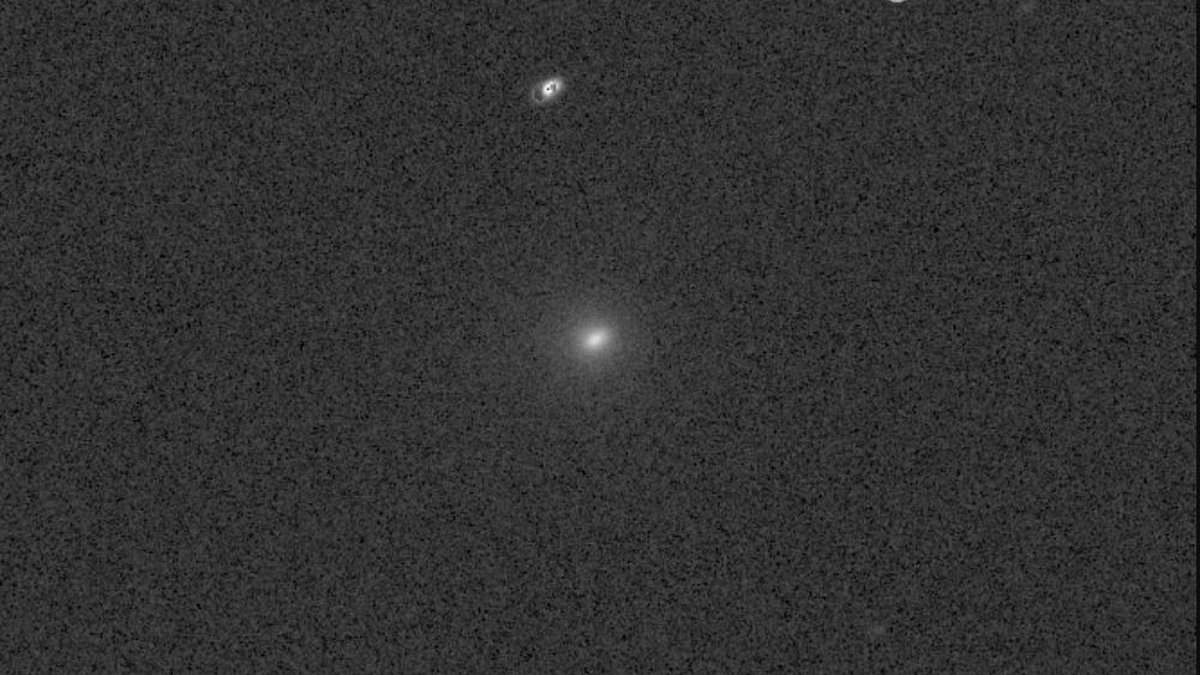Copyright dailymail

Interstellar Comet 3I/ATLAS is seen for the first time since it disappeared behind the sun – and it's even BRIGHTER than when it went in READ MORE: Interstellar visitor proves Einstein's theory By WILIAM HUNTER, SCIENCE & TECHNOLOGY REPORTER Published: 12:01 GMT, 4 November 2025 | Updated: 12:01 GMT, 4 November 2025 Interstellar comet 3I/ATLAS has been spotted for the first time since it disappeared behind the sun. Using the Lowell Observatory's powerful Discovery Telescope, astronomer Dr Qicheng Zhang managed to snap the mysterious object as it sped back into Earth's line of sight. The optical observations show that 3I/ATLAS is now even brighter than when it went in. Scientists have been carefully watching 3I/ATLAS since it was first detected by the Asteroid Terrestrial-impact Last Alert System (ATLAS) telescope on July 1. In early October, the comet vanished from Earth's view as it approached its closest point to the sun, known as perihelion. As it approached a distance of 130 million miles (210 million kilometres), the sun started to evaporate the outer layers of ice into a cloud of glowing gas. According to Dr Zhang, the comet is now bright enough for even amateur telescopes to pick up. 'Interstellar comet 3I/ATLAS is now rising early enough in morning twilight to be seen even with small telescopes under imperfect conditions,' he explained in his blog. Scientists have spotted the interstellar comet 3I/ATLAS for the first time since it disappeared behind the sun in early October 3I/ATLAS is the third time that scientists have managed to detect an object travelling from another solar system. It is moving on an unusually flat and straight path at speeds over 130,000 miles per hour (210,000 km/h) 3I/ATLAS is travelling through our solar system on an unusually flat and straight path at speeds over 130,000 miles per hour (210,000 km/h). Although it will not stay in the solar system for long, its trajectory has been bent around the sun's gravitational pull. Professor Mark Burchell, an astronomer from the University of Kent, told Daily Mail: 'A swing round the sun is perfectly normal behaviour for a comet. 'The term swing is a slight exaggeration; it is attracted by the sun's great mass, and its orbit gets deflected a bit, but it is not a tight sling shot effect, more a slow change of course.' Having passed perihelion on Halloween, October 31, 3I/ATLAS is now just starting to be visible to Earth-based telescopes. Dr Zhang was able to spot the comet with both the Discovery Telescope and his personal commercial telescope. He told Live Science: 'All you need is a clear sky and a very low eastern horizon. 'It won't look very impressive, it's just a smudge, but it will be an increasingly visible smudge over the next few days.' Having passed its closest point to the sun, 3I/ATLAS is now so bright that it can be seen with standard amateur telescopes in the northern hemisphere Over the coming weeks, the comet will be visible higher in the sky, which will allow larger observatories to start capturing images. Although 3I/ATLAS wasn't visible from Earth as it passed around the sun, it has not been totally hidden. Scientists have been using space telescopes such as those orbiting Mars or NASA's Psyche mission to watch the comet as it passed behind the sun. These observations have revealed that 3I/ATLAS has undergone a major transformation while it was hiding out of view. Dr Zhang found that the interstellar object underwent a rapid brightening ahead of reaching perihelion and also took on a distinctively blue hue. Their study found that the comet was brightening at twice the normal rate, which suggests some big changes were taking place on the surface. Dr Matthew Genge, an expert on comets and meteors from Imperial College London, told Daily Mail: 'Comets usually produce more gas as they approach the sun and become brighter. Their surface heats up, and more and more ice is turned to gas. It's like turning the kettle on.' The fact that this comet turned blue also hints that gases, rather than just dust, are responsible for a large part of the brightening. As it approached the sun, the heat caused outer layers of ice and dust to evaporate. This has produced the glowing cloud which surrounds 3I/ATLAS As the comet moves away from the sun and into Earth's view, astronomers will be able to watch these ongoing transformations to learn more about our interstellar visitor. Dr Genge says: 'As it moves away from the sun, its gas tail will point directly away from the Sun, ahead of the comet, since it is swept by the solar wind. In contrast, its tail of dust will trail behind the comet.' By studying the gases it leaves behind, scientists hope to learn more about the solar system 3I/ATLAS came from and how it differs from comets from our own neighbourhood. For instance, scientists have already found that the comet's surface has been transformed by billions of years of exposure to harsh gamma radiation while travelling through space. This has given 3I/ATLAS a thick, irradiated crust that has been responsible for the unusual amounts of CO2 released by the comet. Professor Marina Galand, a planetary scientist from Imperial College London, told Daily Mail: 'After perihelion, a deeper layer below the surface will have been revealed. 'It will be interesting to see how the composition of the gas changes as the comet gets further away from the Sun, compared with when it approached it.' However, despite rampant speculation, one thing scientists are absolutely sure about is that 3I/ATLAS is definitely a comet. As it leaves the sun, scientists will be able to study how the comet has changed over time. If it got hot enough, pristine layers of ice from another solar system might be revealed. This would offer valuable clues about how stars form Dr Mark Norris, an astronomer at the University of Lancashire, told Daily Mail: 'In terms of why we think it is a comet, it is because it looks and acts exactly like a comet. 'It is just happening faster because this comet is moving so much faster than solar system comets, which remain gravitationally bound to the Sun.' There are still a lot of questions to answer about this object, but that is mainly because it is only the third interstellar object humanity has ever discovered. Dr Genge adds: 'Aliens would be literally barmy to hollow out a comet for a spacecraft.' Scientists reveal all the strange behaviors of interstellar visitor 3I/ATLAS The enormous mass would make changing direction nearly impossible, and the layers of ice would add major complications. Although the ice would offer protection from radiation, CO2 needs temperatures lower than -56°C (-68.8°F) to stay frozen. 'Flip on a heater, oven, or engine, and the heat would make lots of gas,' says Dr Genge. 'If you wanted to go unnoticed, then painting your ship black seems a sensible solution for anyone clever enough to be able to travel between stars.' Explained: The difference between an asteroid, meteorite and other space rocks An asteroid is a large chunk of rock left over from collisions or the early solar system. Most are located between Mars and Jupiter in the Main Belt. A comet is a rock covered in ice, methane and other compounds. Their orbits take them much further out of the solar system. A meteor is what astronomers call a flash of light in the atmosphere when debris burns up. This debris itself is known as a meteoroid. Most are so small they are vapourised in the atmosphere. If any of this meteoroid makes it to Earth, it is called a meteorite. Meteors, meteoroids and meteorites normally originate from asteroids and comets. For example, if Earth passes through the tail of a comet, much of the debris burns up in the atmosphere, forming a meteor shower. Share or comment on this article: Interstellar Comet 3I/ATLAS is seen for the first time since it disappeared behind the sun - and it's even BRIGHTER than when it went in Add comment



